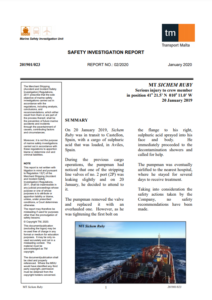Transport Malta MSIU issued an investigation report on a serious injury of a crew member onboard the tanker ‘Sichem Ruby’ off Spain in January 2019. While the pumpman was tightening the bolt, the Teflon blank dislodged and gave way under the pressurised sulphuric acid, which remained trapped in the pipeline.
The incident
On 20 January 2019, Sichem Ruby was in transit to Castellon, Spain, with a cargo of sulphuric acid that was loaded, in Aviles, Spain.
During the previous cargo operations, the pumpman had noticed that one of the stripping line valves of no. 2 port (2P) was leaking slightly and on 20 January, he decided to attend to it.
The pumpman removed the valve and replaced it with an overhauled one.
At that time, the pumpman was wearing an overall and a pair of safety shoes, as part of his personal protective equipment.
However, as he was tightening the first bolt on the flange to his right, sulphuric acid sprayed into his face and body.
The pumpman started shouting and immediately ran to the decontamination shower on the port side, but found no water.
He went over to the starboard side, by which time, one ordinary seafarer (OS) noticed him running.
The OS went directly to help him and opened the fresh water supply line for the pumpman to flush his face and body with fresh water.
He was eventually airlifted to the nearest hospital, where he stayed for several days to receive treatment.
The pumpman had suffered from chemical burns affecting his face, neck, both upper extremities and right thigh.
His right eye was injured and consequently, his vision deteriorated after this accident. Following repatriation, he continued receiving medical treatment at a local hospital.
Immediate cause
Sulphuric acid sprayed from between the Teflon blank and the pipeline flange which was to the pumpman’s right side, while the pumpman was securing the first bolt on the reconditioned valve.
It is the view of this safety investigation, that while tightening the bolt, the Teflon blank dislodged and gave way under the pressurised sulphuric acid, which remained trapped in the pipeline.
Conclusions
- Sulphuric acid splashed on the pumpman during maintenance work on the stripping line;
- The crew adopted different cargo stripping procedures because the P & A Manual seemed unclear;
- Teflon blanks were installed on all stripping lines, for each cargo tank, possibly to eliminate potential issues with leaking valves on draining lines;
- The pumpman was the only person onboard aware of these Teflon blanks;
- The Teflon blank, which was installed on the manifold side of the stripping line of no. 2P, was found cracked;
- Sulphuric acid had entered no. 2P stripping line pipeline through the cracked Teflon blank and the ball valve that was being kept open while draining the lines;
- The pumpman could not have envisaged that sulphuric acid was trapped in the pipeline;
- The safety equipment and clothing worn by the pumpman were not adequate to protect him from chemical injuries;
- Outcome bias of the task in hand, could have led the pumpman to carry out the task without the necessary permit;
- The decontamination showers were not immediately available – supply of fresh water to these showers was only opened by another crew member.
Actions taken
During the course of the safety investigation, the company took the following actions:
- Removal of all Teflon blanks from all pipelines and checks on sister vessel for any similar blanks;
- Reinforcing of PPE campaign for routine maintenance jobs for the whole fleet;
- A reporting and communication campaign was launched for the whole fleet to highlight problems with lack of reporting to line officer or to the Company, accordingly;
- A campaign to reinforce the use of toolbox talk meetings and relevant work permits for the whole fleet was launched;
- A campaign to reinforcing the reporting and recording of any isolated/blanked equipment/piping was initiated;
- Sharing of the case’s findings with all group vessels as a learning engagement tool;
- The SMS Manual has been amended to ensure that whenever the vessel is carrying corrosive cargoes and slops, emergency showers are kept ready for immediate use and supplied with water even if no cargo operations are in progress;
- The lessons learned have been distributed to all vessels within the Fleet and are being highlighted during crew seminars and senior officials’ briefings.
Explore more herebelow:



































































Incorrect purging and washing of the stripping line, incorrect PPE worn, while it was obvious the leak should contain be the previous acid cargo. Furthermore, the master (and of course the chief officer) should visit the vessel daily, yet only the bossun knew about the teflon blanks? No one noticed there’s something odd?